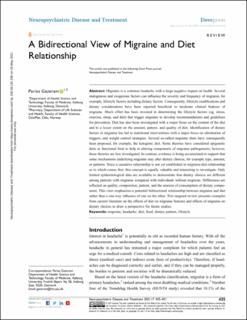| dc.description.abstract | Migraine is a common headache with a large negative impact on health. Several endogenous and exogenous factors can influence the severity and frequency of migraine, for example, lifestyle factors including dietary factors. Consequently, lifestyle modifications and dietary considerations have been reported beneficial to moderate clinical features of migraine. Much effort has been invested in determining the lifestyle factors (eg, stress, exercise, sleep, and diet) that trigger migraine to develop recommendations and guidelines for prevention. Diet has also been investigated with a major focus on the content of the diet and to a lesser extent on the amount, pattern, and quality of diet. Identification of dietary factors in migraine has led to nutritional interventions with a major focus on elimination of triggers, and weight control strategies. Several so-called migraine diets have consequently been proposed, for example, the ketogenic diet. Some theories have considered epigenetic diets or functional food to help in altering components of migraine pathogenesis; however, these theories are less investigated. In contrast, evidence is being accumulated to support that some mechanisms underlying migraine may alter dietary choices, for example type, amount, or patterns. Since a causative relationship is not yet established in migraine-diet relationship as to which comes first, this concept is equally valuable and interesting to investigate. Only limited epidemiological data are available to demonstrate that dietary choices are different among patients with migraine compared with individuals without migraine. Differences are reflected on quality, composition, pattern, and the amount of consumption of dietary components. This view emphasizes a potential bidirectional relationship between migraine and diet rather than a one-way influence of one on the other. This targeted review presents examples from current literature on the effects of diet on migraine features and effects of migraine on dietary choices to draw a perspective for future studies. | en_US |

